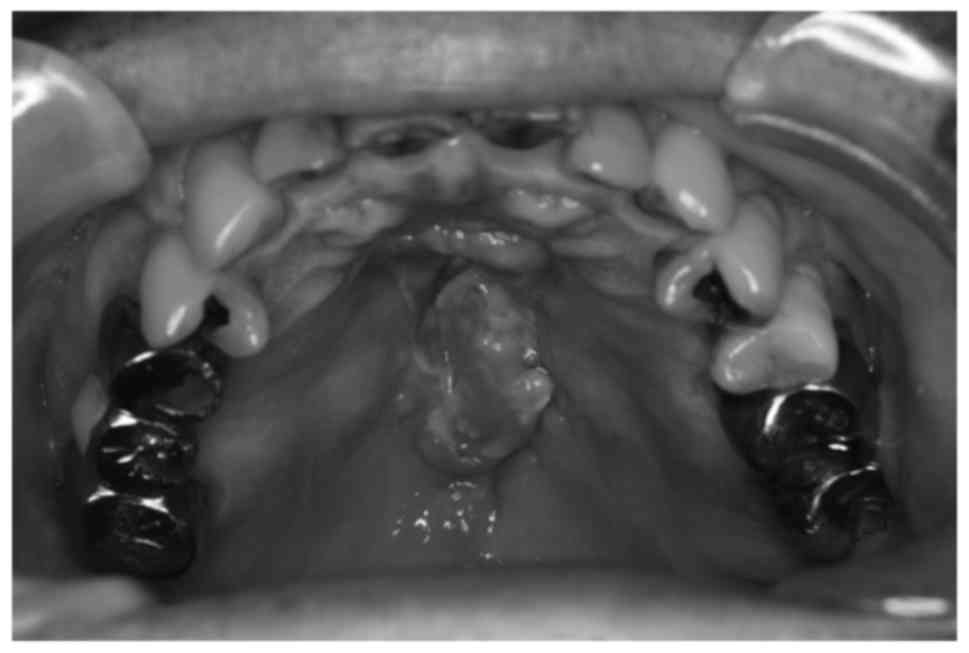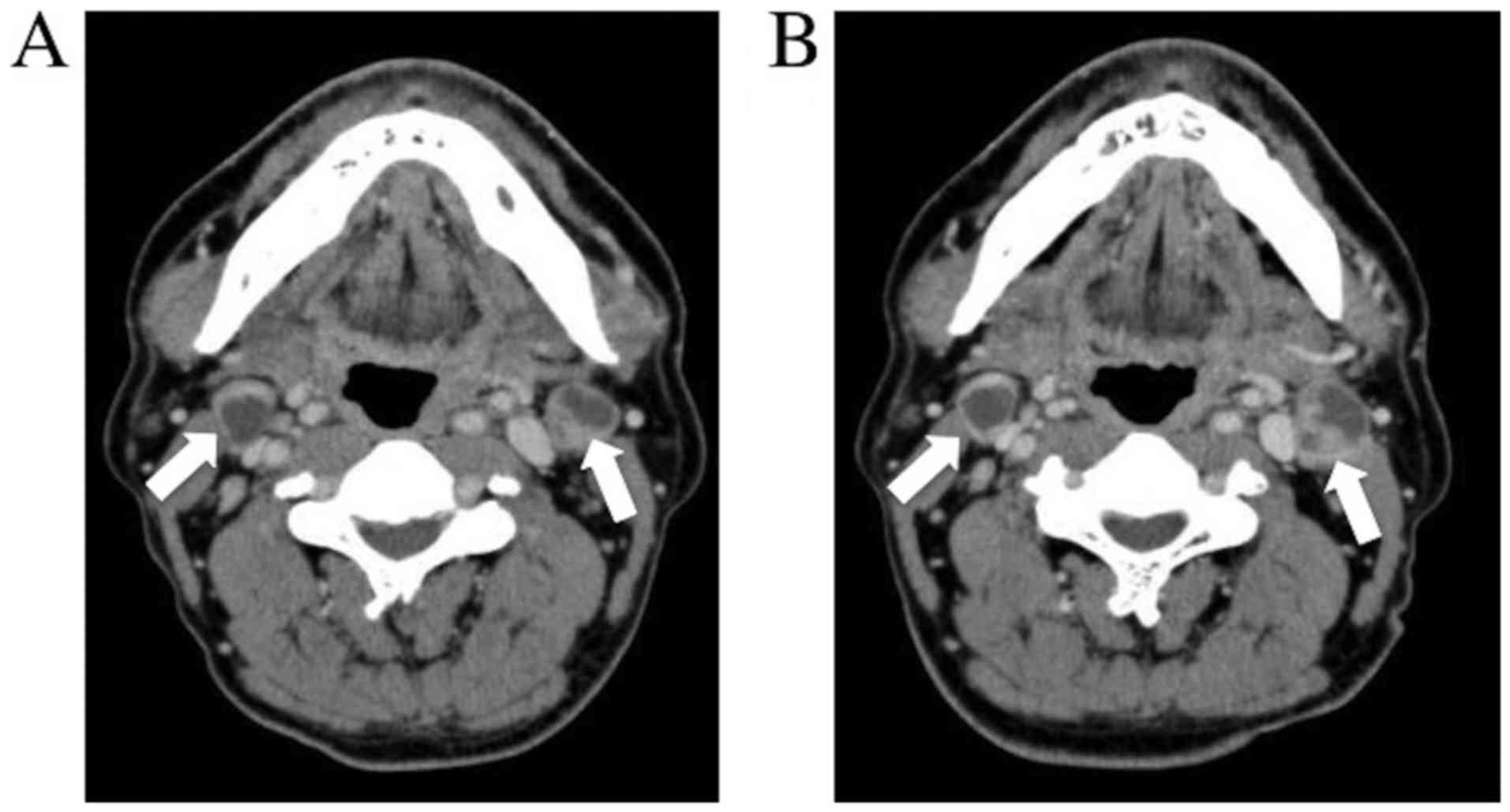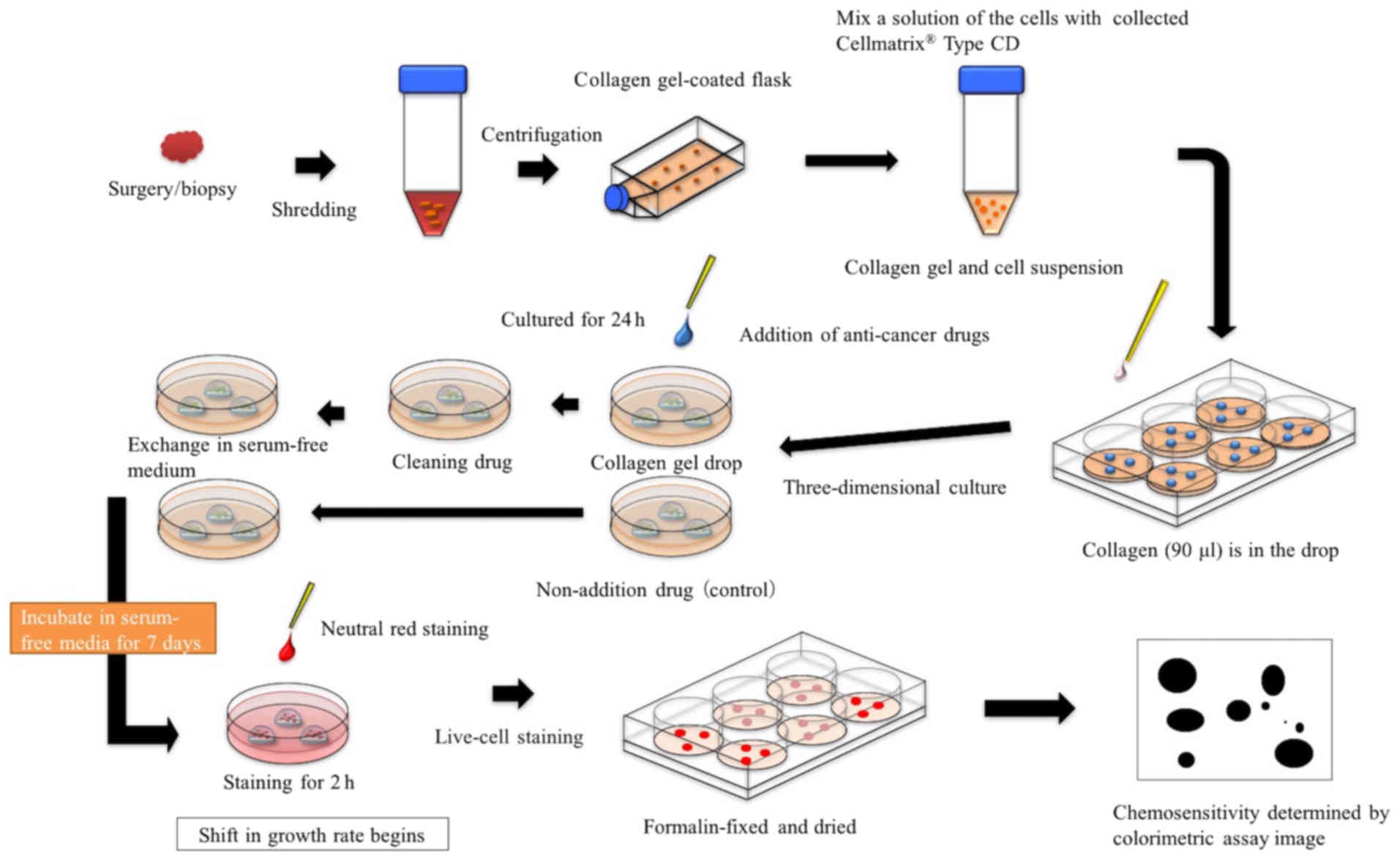Collagen gel droplet-embedded culture drug sensitivity testing in hard palate cancer‑predicted antitumor efficacy of cetuximab: A case report
- Authors:
- Published online on: August 8, 2017 https://doi.org/10.3892/mco.2017.1367
- Pages: 637-641
Abstract
Introduction
The recent introduction of the anticancer drug cetuximab [an epidermal growth factor receptor (EGFr) inhibitor: C-mab] as a molecular-targeted therapy for treating head and neck cancers has expanded the scope of anticancer drugs for treating these cancers. However, no biomarkers are currently available that can predict C-mab efficacy against oral squamous cell carcinoma (OSCC); therefore, it is typically administered irrespective of patient sensitivity (1). Hence, we investigated C-mab use with the collagen gel droplet-embedded culture drug sensitivity test (CD-DST). Kobayashi et al (2,3) developed CD-DST which combines the collagen gel droplet culture method, a simple method of three-dimensional (3D) culture that allows a very small number of clinical samples to be tested with a serum-free medium step and quantitative evaluation by image analysis. CD-DST has little effect on non-cancerous cells, allowing accurate measurements of cancerous cells only. This method has been primarily used on tumors of the digestive system (4–6). Compared to such cancers of the primary organs, OSCC and other oral cancers generally have a smaller tumor volume. CD-DST is, therefore, likely to be a suitable method for testing the sensitivity of anticancer drugs on OSCC. However, there is little application of the CD-DST method to OSCC, with no evaluation of molecularly targeted drugs. In the present study, the CD-DST method was performed using a patient biopsy specimen of hard palate cancer to discern chemotherapy combined with a molecularly targeted drug at retrospective.
Case report
A 55-year-old man with hard palatal pain was referred to our institution in July 2012. An ulcerative mass measuring 35×17×8 mm3 with induration at the border of the hard palate was observed (Fig. 1). The patient also had bilateral neck metastasis at level IIa. The hard palatal mass was diagnosed as well-differentiated squamous cell carcinoma. Contrast-enhanced computed tomography (e-CT) showed a rim-enhanced mass at level IIa of the bilateral cervical area. In addition, it was close to the internal carotid artery (Fig. 2A). Positron emission tomography-computed tomography demonstrated high 18-fluorodeoxyglucose uptake at the hard palatal and cervical lymph nodes. The distant metastasis workup was negative. Diagnosis was hard palatal cancer, cervical lymph node metastasis (T2N2cM0: Stage IVA). CD-DST results revealed that the tumor was sensitive to various chemotherapeutic agents. The patients underwent one course of induction chemotherapy [docetaxel (DOC): 80 mg/body; cisplatin (CDDP): 80 mg/body; 5-fluorouracil (5-FU): 4,000 mg/body] following the diagnosis of hard palate cancer. The treatment effect of chemotherapy was confirmed with the Response Evaluation Criteria in Solid Tumors (RECIST) guideline version 1.1 (7). The size of the lymph node metastasis did not change as per e-CT after neoadjuvant chemotherapy. The therapy effect determination was stable disease (SD) (Fig. 2B). We performed maxillary malignant tumor resection and bilateral radical neck dissection under general anesthesia. However, left cervical lymph node metastasis recurrence and neck skin metastasis were observed eight months after surgery (Fig. 3). In accordance with the report of Vermorken et al (1), C-mab + CDDP + 5-FU (C-mab: 1450 mg/body; CDDP: 150 mg/body; 5-FU: 5,000 mg/body) was started and a total of six courses were performed. At the end of the six courses, we confirmed by CT that cervical lymph node recurrence and skin metastasis showed marked reduction of tumors, and therapy effect determination was partial response (PR) (Fig. 4). Thereafter, once weekly administration of C-mab alone was continued three times; however, there was a rapid increase in cervical skin metastatic tumors. The therapy effect determination became progressive disease (PD), and the treatment was canceled. As the symptoms worsened, it shifted to best support care focused on pain management. He died 330 days after cervical skin metastasis was confirmed.
The ethics committee of Nippon Dental University, School of Life Dentistry at Niigata (approval no. ECNG-H-119) approved study. CDDP, 5-FU, DOC, and C-mab, which are chemotherapeutic drugs frequently used for oral cancer, were assessed for in vitro chemosensitivity via the CD-DST method. CD-DST was performed according to the method described by Kobayashi et al (2,3), using the Primaster® human cancer cell primary culture kit (Kurabo Industries Ltd., Osaka, Japan) (Fig. 5). Contact concentration and time of anticancer agents were as follows: 0.5 µg/ml CDDP (8), 0.7 µg/ml 5-FU (8), 0.1 µg/ml DOC (9) contacted for 24 h. The contact concentration of C-mab was set at 250 µg/ml for 144 h, which is the maximum blood concentration during clinical administration. In addition, the test was also performed with a dose of 500 µg/ml. Drug efficacy was determined via image analysis (Solution Systems Inc., Chiba, Japan). The growth rates of control incubations were calculated as the total volume on day 7/total volume on day 0. The in vitro sensitivity was expressed as the percentage T/C, where T was the total volume of the treated group and C was the total volume of the control group. When T/C was less than or equal to 50%, the in vitro drug sensitivity was regarded as effective. In contrast, when T/C was greater than 50%, sensitivity was considered as not effective (2,3). Clinical responses were assessed according to RESIST, where tumors demonstrating a complete response (CR) or a PR were considered clinically responsive.
Result
Results of CD-DST and clinical response are shown in Table I. In CDDP single agent, T/C was 97.6%, which was a low sensitivity. In DOC single agent, T/C was 76.9%, which was a low sensitivity. In 5-FU single agent, T/C was 83.2%, which was a low sensitivity. In C-mab 250 µg/ml single agent and C-mab 500 µg/ml single agent, T/C was 65.5 and 60.1%, which was a low sensitivity. In multiple drug combination PF, T/C was 93.2%, which was a low sensitivity. In C-mab + PF, T/C was 32.4%, which was a high sensitivity. In multiple drug combination TPF, T/C was 71.6%, which was a low sensitivity. The clinical response of neoadjuvant chemotherapy (TPF) was SD. The clinical response of C-mab + PF was PR. In addition, the clinical response of C-mab single agent was PD.
Discussion
C-mab, which specifically binds to EGFr, is a promising novel chemotherapy drug for treating OSCC. However, there are no established predictors of OSCC therapeutic responses, and this inability to predict tumor response has resulted in drugs being administered to patients irrespective of tumor sensitivity. C-mab reportedly causes infusion reactions and other serious adverse events (1,10). Therefore, identifying a predictor of OSCC patient therapeutic response is essential to eliminating ineffective drug administration and associated patient risks. To further increase the effective rate of chemotherapy, an anticancer drug sensitivity test that accurately reflects the clinical prognosis is necessary.
Presently, various chemotherapy sensitivity tests have been developed and performed, such as HTCA, SDI, and HDRA (11–13). HDRA is an anticancer drug sensitivity test using 3D cell culture, but it entails problems such as the requirement for a large number of cells and the influence of contaminating fibroblasts. In contrast, CD-DST is capable of analyzing a small number of cells (1×105) in 3D cell cultures that create an environment close to that of the body and is unaffected by contaminating fibroblasts, thus achieving high positive and negative predictive values (2,3).
Measurement success rates of ≥80% have been obtained for cancers, including colorectal cancer (14), lung cancer (15), and breast cancer (9), and a high clinical efficacy prediction rate of 91% has been obtained via CD-DST (3). This study evaluated its application to chemosensitivity testing for OSCC. In this study, it was possible to judge susceptibility to anticancer drugs without concerns such as the lack of cell numbers and bacterial contamination. OSCC and other oral cancers generally have a smaller tumor volume. Thus, CD-DST is likely to be a suitable method for testing the sensitivity of anticancer drugs on OSCC.
We performed CD-DST method on metastatic lymph node resected after neoadjuvant chemotherapy. In this study, the combination of TPF showed low sensitivity (T/C %: 71.6). The effect of preoperative chemotherapy (TPF) was determined as SD as lymph node metastasis did not change. In a retrospective examination, the CD-DST method and clinical response were consistent, suggesting that evaluation of multiple drug combination chemotherapy is possible in OSCC.
Furthermore, PF and C-mab each had low sensitivity with a single agent; however, when tested in combination, T/C was 32.4%, which was a high sensitivity value. The therapy effect determination was PR at the end of six cycles, consistent with the CD-DST method result. The CD-DST method could reproduce the synergistic effect of C-mab on PF therapy for OSCC. In this respect, synergistic antitumor activity has been reported in combination experiments with chemotherapeutic drugs or molecular-targeted therapeutic drugs. Combination treatment with cisplatin and gefitinib has confirmed in vitro sufficient additive inhibitory action on the survival of cancer cells (head and neck cancer) (16,17). However, the putative mechanism through which C-mab combination therapy enhances antitumor response remains to be demonstrated. Therefore, if the effect of PF + C-mab can be evaluated by the CD-DST method, antitumor effect can be expected to be comprehensively judged without considering factors such as EGFr expression level and resistance gene. In addition, in this study CD-DST method, C-mab alone has a low sensitivity, but based on the EXTREME trial (1), we continued administering C-mab alone once a week after six cycles of C-mab + PF. Cervical skin metastasis increased rapidly in about one month after changing to C-mab single administration. The clinical response was PD, and the susceptibility test of C-mab single agent was consistent with low sensitivity (C-mab 250 µg/ml: 65.5%, 500 µg/ml: 60.1%). In this respect, our case report demonstrated that it was possible to evaluate even multi-drug-combined chemotherapy regimens, including C-mab. However, Anti-tumor effects of C-mab include antibody-dependent cell-mediated cytotoxicity (ADCC) activity and the like in addition to the signal inhibitory effect on EGFr (18), further study is necessary. The accumulation and analyses of additional cases are required to conduct a precise evaluation of CD-DST for patients with OSCC.
References
|
Vermorken JB, Mesia R, Rivera F, Remenar E, Kawecki A, Rottey S, Erfan J, Zabolotnyy D, Kienzer HR, Cupissol D, et al: Platinum-based chemotherapy plus cetuximab in head and neck cancer. N Engl J Med. 359:1116–1127. 2008. View Article : Google Scholar : PubMed/NCBI | |
|
Kobayashi H, Tanisaka K, Kondo N, Mito Y, Koezuka M, Yokouchi H, Higashiyama M, Kodama K, Doi O, Yamada M, et al: Development of new in vitro chemosensitivity test using collagen gel droplet embedded culture and its clinical usefulness. Gan To Kagaku Ryoho. 22:1933–1939. 1995.(In Japanese). PubMed/NCBI | |
|
Kobayashi H, Tanisaka K, Doi O, Kodama K, Higashiyama M, Nakagawa H, Miyake M, Taki T, Hara S, et al: An in vitro chemosensitivity test for solid human tumors using collagen gel droplet embedded cultures. Int J Oncol. 11:449–455. 1997.PubMed/NCBI | |
|
Naitoh H, Yamamoto H, Murata S, Kobayashi H, Inoue K and Tani T: Stratified phase II trial to establish the usefulness of the collagen gel droplet embedded culture-drug sensitivity test (CD-DST) for advanced gastric cancer. Gastric Cancer. 17:630–637. 2014. View Article : Google Scholar : PubMed/NCBI | |
|
Ochiai T, Nishimura K, Watanabe T, Kitajima M, Nakatani A, Inou T, Washio M, Sakuyama N, Sato T, Kishine K, et al: Individualized chemotherapy for colorectal cancer based on the collagen gel droplet-embedded drug sensitivity test. Oncol Lett. 4:621–624. 2012.PubMed/NCBI | |
|
Mekata E, Sonoda H, Shimizu T, Tatsuta T, Yamaguchi T, Endo Y and Tani T: Clinical predictive value of in vitro anticancer drug sensitivity test for the therapeutic effect of adjuvant chemotherapy in patients with stage II–III colorectal cancer. Mol Clin Oncol. 1:763–767. 2013.PubMed/NCBI | |
|
Eisenhauer EA, Therasse P, Bogaerts J, Schwartz LH, Sargent D, Ford R, Dancey J, Arbuck S, Gwyther S, Mooney M, et al: New response evaluation criteria in solid tumours: Revised RECIST guideline (version 1.1). Eur J Cancer. 45:228–247. 2009. View Article : Google Scholar : PubMed/NCBI | |
|
Sakuma K, Tanaka A and Mataga I: Collagen gel droplet-embedded culture drug sensitivity testing in squamous cell carcinoma cell lines derived from human oral cancers: Optimal contact concentrations of cisplatin and fluorouracil. Oncol Lett. 12:4643–4650. 2016.PubMed/NCBI | |
|
Takamura Y, Kobayashi H, Taguchi T, Motomura K, Inaji H and Noguchi S: Prediction of chemotherapeutic response by collagen gel droplet embedded culture-drug sensitivity test in human breast cancers. Int J Cancer. 98:450–455. 2002. View Article : Google Scholar : PubMed/NCBI | |
|
Yoshino T, Hasegawa Y, Takahashi S, Monden N, Homma A, Okami K, Onozawa Y, Fujii M, Taguchi T, de Blas B, et al: Platinum-based chemotherapy plus cetuximab for the first-line treatment of Japanese patients with recurrent and/or metastatic squamous cell carcinoma of the head and neck: Results of a phase ii trial. Jpn J Clin. 43:524–531. 2013. View Article : Google Scholar | |
|
Salmon SE, Mamburger AW, Soehnlen B, Durie BG, Alberts DS and Moon TE: Quantitation of differential sensitivity of human tumor stem cells to anticancer drugs. N Engl J Med. 298:1321–1327. 1978. View Article : Google Scholar : PubMed/NCBI | |
|
Tanigawa N, Kern DH, Hisaka Y and Morton DL: Rapid assay for evaluating the chemosensitivity of human tumors in soft agar culture. Cancer Res. 42:2159–2164. 1982.PubMed/NCBI | |
|
Kern DH, Dogemullar CR, Kennedy MC, Hildebrand-Zanki SU, Tanigawa N and Sondak VK: Development of miniaturized, improved nucleic acid precursor incorporation assay for chemosensitivity testing of human solid tumors. Cancer Res. 45:5436–5441. 1985.PubMed/NCBI | |
|
Araki Y, lsomoto H, Matsumoto A, Kaibara A, Yasunaga M, Hayashi K, Yatsugi H and Yamauchi K: An in vitro chemosensitivity test for colorectal cancer using collagen-gel droplet embedded cultures. Kurume Med J. 46:163–166. 1999. View Article : Google Scholar : PubMed/NCBI | |
|
Kawamura M, Inoue Y, Oyama T and Kobayashi K: Chemosensitivity test for unresectable non-small cell lung cancer. Nihon Geka Gakkai Zasshi. 103:229–232. 2002.(In Japanese). PubMed/NCBI | |
|
Prewett M, Rockwell P, Rose C and Goldstein N: Anti-tumor and cell cycle responses in KB cells treated with a chimeric anti-EGFR monoclonal antibody in combination with cisplatin. Int J Oncol. 9:217–224. 1996.PubMed/NCBI | |
|
Huang S, Armstrong EA, Benavente S, Chinnaiyan P and Harari PM: Dual-agent molecular targeting of the epidermal growth factor receptor (EGFR): Combining anti-EGFR antibody with tyrosine kinase inhibitor. Cancer Res. 64:5355–5362. 2004. View Article : Google Scholar : PubMed/NCBI | |
|
Kimura H, Sakai K, Arao T, Shimoyama T, Tamura T and Nishio K: Antibody- dependent cellular cytotoxicity of cetuximab against tumor cells with wild-type or mutant epidermal growth factor receptor. Cancer Sci. 98:1275–1280. 2007. View Article : Google Scholar : PubMed/NCBI |














